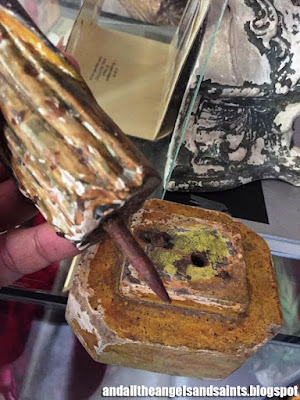In a similar vein, representations of Sta. Ana follow the
Western format—and extant devotional folk santos often depicts her with the
young Maria—either seated or standing-showing an open book to her daughter.
This outstanding antique Sta. Ana with Nina Maria, the child
Mary, is one such example. The well carved figures of Sta. Ana (12 in.”) and
Maria (9.5”) stand on a cloud base bringing the total height to 18 inches. The figures
are blackened with patina but traces of paint remain on their clothing—Sta. Ana is dressed in a red robe, yellow mantle with blue lining. She also wears a form
fitting coif and wimple.
Maria is in yellow, adorned with floral prints. Her long
tresses are intricately defined with detailed carving. Both santos are shown
with heavily lidded eyes, with Maria showing a ringed neck, dating the images to
early 19th century.
There is reason to believe that the cloud base, on which two small cherubims are affixed, is not original to the piece, as the peg holes do not exactly match those of the santo figures.
The pedestal on which the cloud base stands is obviously a later addition, a tad too high for such santos. Similar crescent-shaped cloud bases are seen used in representations of the Blessed Virgin, but not on typical Sta. Ana images. Nevertheless, the base is also superbly carved.
In the Late Middle Ages, legend held that Sta. Ana was married
three times: first to Joaquin, then to Clopas (Cleofas) and finally to a man named
Solomas and that each marriage produced one daughter: Sta. Maria, mother of Jesus,
Sta. Maria Cleofe, and Sta. Maria
Salome, respectively.
Sta. Ana is the patroness of unmarried women, housewives,
women in labor or who want to be pregnant, grandmothers, mothers and educators.
Duchet-Suchaux G., Pastoureau M.,The Bible and the Saints: Flammarion Iconographic Guide, pp. 32-33
Sheingorn, Pamela. “The Wise Mother”; the Image of St. Anne Teaching the Virgin Mary, Vol. 32, No. 1 (1993), pp. 69-80 (12 pages), The University of Chicago Press, https://www.jstor.org/stable/767018


.JPG)













































